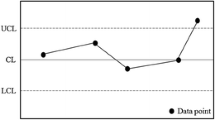Abstract
The fatigue crack cycle is calculated via a specimen experiment under specific stress conditions; however, the experimental results are scattered due to various causes (e.g., experimental conditions, material specifications). Therefore, the fatigue crack cycle is evaluated by fitting it to a specific probability model after carrying out a sufficient amount of testing. If the number of tests is insufficient, a specific probability model is unobtainable. The uncertainty due to an insufficient number of tests is referred to as the epistemic uncertainty. In this paper, evidence theory is employed to deal with epistemic uncertainty. Through the use of evidence theory, belief and plausibility functions are obtained. Belief and plausibility may be implied as the lower and upper bounds for the limited state function. Here, the belief and plausibility functions are approximated to the Kriging meta-model using sample data generated by the Cartesian product. These approximated functions can then be used to calculate the optimal solution using a genetic algorithm. Finally, the fatigue crack cycle is predicted in terms of the interval (belief and plausibility).
Similar content being viewed by others
Abbreviations
- C :
-
material constant
- n :
-
material constant
- ΔK :
-
stress intensity factor range
- a i :
-
initial crack length
- a f :
-
critical crack length
- N f :
-
the number of cycles to reach material fracture
- Bel :
-
upper bound
- Pl :
-
lower bound
- K c :
-
fracture toughness
- f i :
-
constant value representing crack geometry
References
Liu, Y. and Mahadevan, S., “Probabilistic Fatigue Life Prediction using an Equivalent Initial Flaw Size Distribution,” International Journal of Fatigue, Vol. 31, No. 3, pp. 476–487, 2009.
Yoon, H., “A Study on the Probabilistic Nature of Fatigue Crack Propagation Life (II)-the Distribution of Crack Propagation Rate,” Journal of the Korea Society of Mechanical Engineers, Ver, Vol. 14, No. 6, pp. 1561–1567, 1990.
Xiang, Y. and Liu, Y., “Application of Inverse First-Order Reliability Method for Probabilistic Fatigue Life Prediction,” Probabilistic Engineering Mechanics, Vol. 26, No. 2, pp. 148–156, 2011.
Shafer, G., “A Mathematical Theory of Evidence,” Princeton University Press Princeton, pp. 10–310, 1976.
Kim, D. W. and Lee, J., “An Improvement of Kriging based Sequential Approximate Optimization Method Via Extended Use of Design of Experiments,” Engineering Optimization, Vol. 42, No. 12, pp. 1133–1149, 2010.
Park, H. S. and Nguyen, T. T., “Optimization of Injection Molding Process for Car Fender in Consideration of Energy Efficiency and Product Quality,” Journal of Computational Design and Engineering, Vol. 1, No. 4, pp. 256–265, 2014.
Anderson, T. L., “Fracture Mechanics: Fundamentals and Applications,” CRC Press, 3rd Ed., pp. 25–212, 2005.
Madenci, E. and Guven, I., “The Finite Element Method and Applications in Engineering using Ansys,” Springer, pp. 139–175, 2006.
Japanese Standards Association, “Calculation Standards for Steel Structures of Cranes,” Document ID: JIS B 8821, 2004.
ASTM E647-95A, “Standard Test Method for Measurement of Fatigue Crack Growth Rates,” ASTM International, 2011.
Author information
Authors and Affiliations
Corresponding author
Rights and permissions
About this article
Cite this article
Kim, D.S., Lee, J. Interval prediction of the fatigue crack cycle using evidence theory and the Kriging meta-model. Int. J. Precis. Eng. Manuf. 16, 2315–2320 (2015). https://doi.org/10.1007/s12541-015-0297-5
Received:
Revised:
Accepted:
Published:
Issue Date:
DOI: https://doi.org/10.1007/s12541-015-0297-5




